Case Briefing - Linton v. State of Texas
VerifiedAdded on 2023/04/23
|13
|3395
|294
AI Summary
Read the case briefing of Linton v. State of Texas, where Linton was found guilty of illegal possession of cocaine. Get a summary, issues, decision, opinion, and rule of law.
Contribute Materials
Your contribution can guide someone’s learning journey. Share your
documents today.

Case Briefing – Professor Becker’s Classes
Secure Best Marks with AI Grader
Need help grading? Try our AI Grader for instant feedback on your assignments.
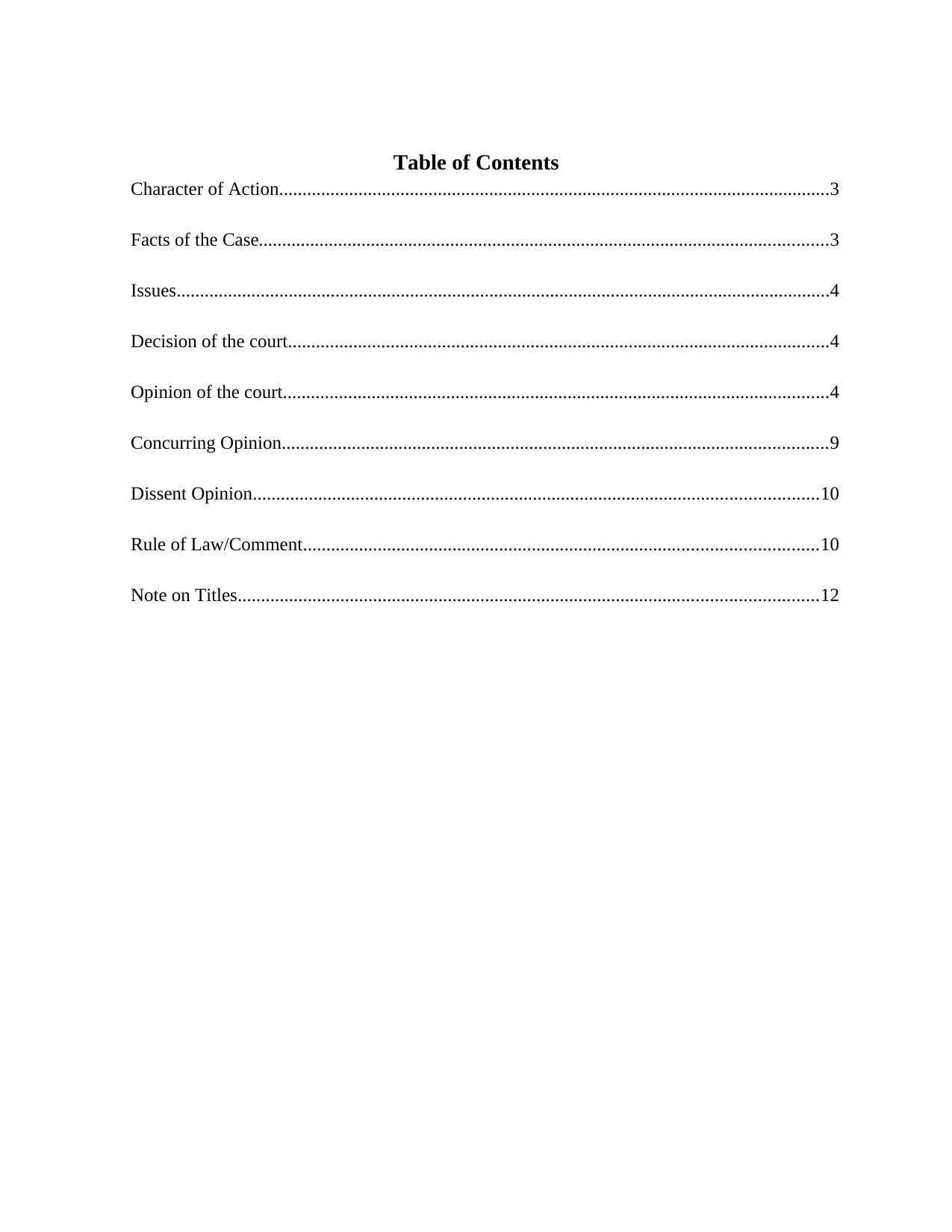
Table of Contents
Character of Action......................................................................................................................3
Facts of the Case..........................................................................................................................3
Issues............................................................................................................................................4
Decision of the court....................................................................................................................4
Opinion of the court.....................................................................................................................4
Concurring Opinion.....................................................................................................................9
Dissent Opinion.........................................................................................................................10
Rule of Law/Comment..............................................................................................................10
Note on Titles............................................................................................................................12
Character of Action......................................................................................................................3
Facts of the Case..........................................................................................................................3
Issues............................................................................................................................................4
Decision of the court....................................................................................................................4
Opinion of the court.....................................................................................................................4
Concurring Opinion.....................................................................................................................9
Dissent Opinion.........................................................................................................................10
Rule of Law/Comment..............................................................................................................10
Note on Titles............................................................................................................................12
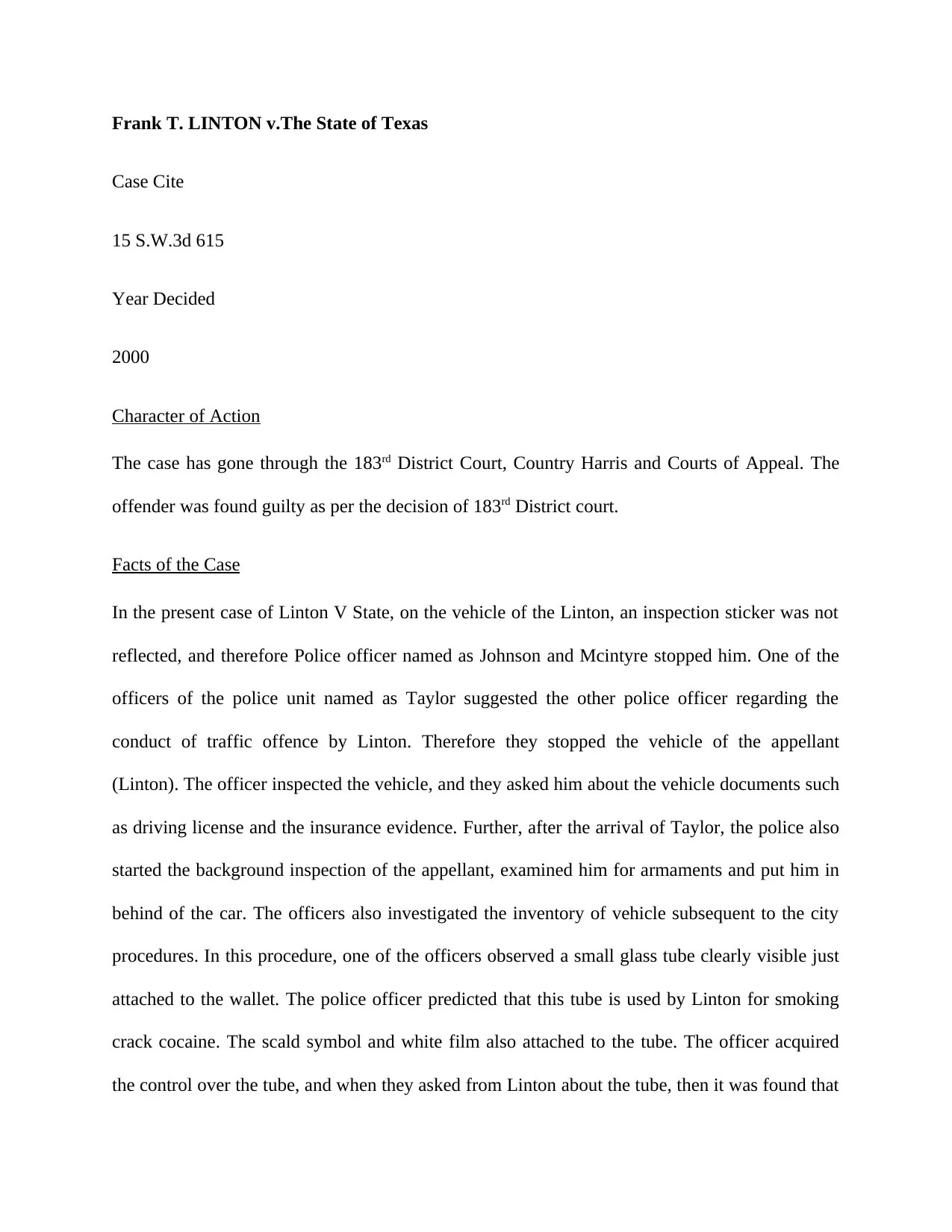
Frank T. LINTON v.The State of Texas
Case Cite
15 S.W.3d 615
Year Decided
2000
Character of Action
The case has gone through the 183rd District Court, Country Harris and Courts of Appeal. The
offender was found guilty as per the decision of 183rd District court.
Facts of the Case
In the present case of Linton V State, on the vehicle of the Linton, an inspection sticker was not
reflected, and therefore Police officer named as Johnson and Mcintyre stopped him. One of the
officers of the police unit named as Taylor suggested the other police officer regarding the
conduct of traffic offence by Linton. Therefore they stopped the vehicle of the appellant
(Linton). The officer inspected the vehicle, and they asked him about the vehicle documents such
as driving license and the insurance evidence. Further, after the arrival of Taylor, the police also
started the background inspection of the appellant, examined him for armaments and put him in
behind of the car. The officers also investigated the inventory of vehicle subsequent to the city
procedures. In this procedure, one of the officers observed a small glass tube clearly visible just
attached to the wallet. The police officer predicted that this tube is used by Linton for smoking
crack cocaine. The scald symbol and white film also attached to the tube. The officer acquired
the control over the tube, and when they asked from Linton about the tube, then it was found that
Case Cite
15 S.W.3d 615
Year Decided
2000
Character of Action
The case has gone through the 183rd District Court, Country Harris and Courts of Appeal. The
offender was found guilty as per the decision of 183rd District court.
Facts of the Case
In the present case of Linton V State, on the vehicle of the Linton, an inspection sticker was not
reflected, and therefore Police officer named as Johnson and Mcintyre stopped him. One of the
officers of the police unit named as Taylor suggested the other police officer regarding the
conduct of traffic offence by Linton. Therefore they stopped the vehicle of the appellant
(Linton). The officer inspected the vehicle, and they asked him about the vehicle documents such
as driving license and the insurance evidence. Further, after the arrival of Taylor, the police also
started the background inspection of the appellant, examined him for armaments and put him in
behind of the car. The officers also investigated the inventory of vehicle subsequent to the city
procedures. In this procedure, one of the officers observed a small glass tube clearly visible just
attached to the wallet. The police officer predicted that this tube is used by Linton for smoking
crack cocaine. The scald symbol and white film also attached to the tube. The officer acquired
the control over the tube, and when they asked from Linton about the tube, then it was found that
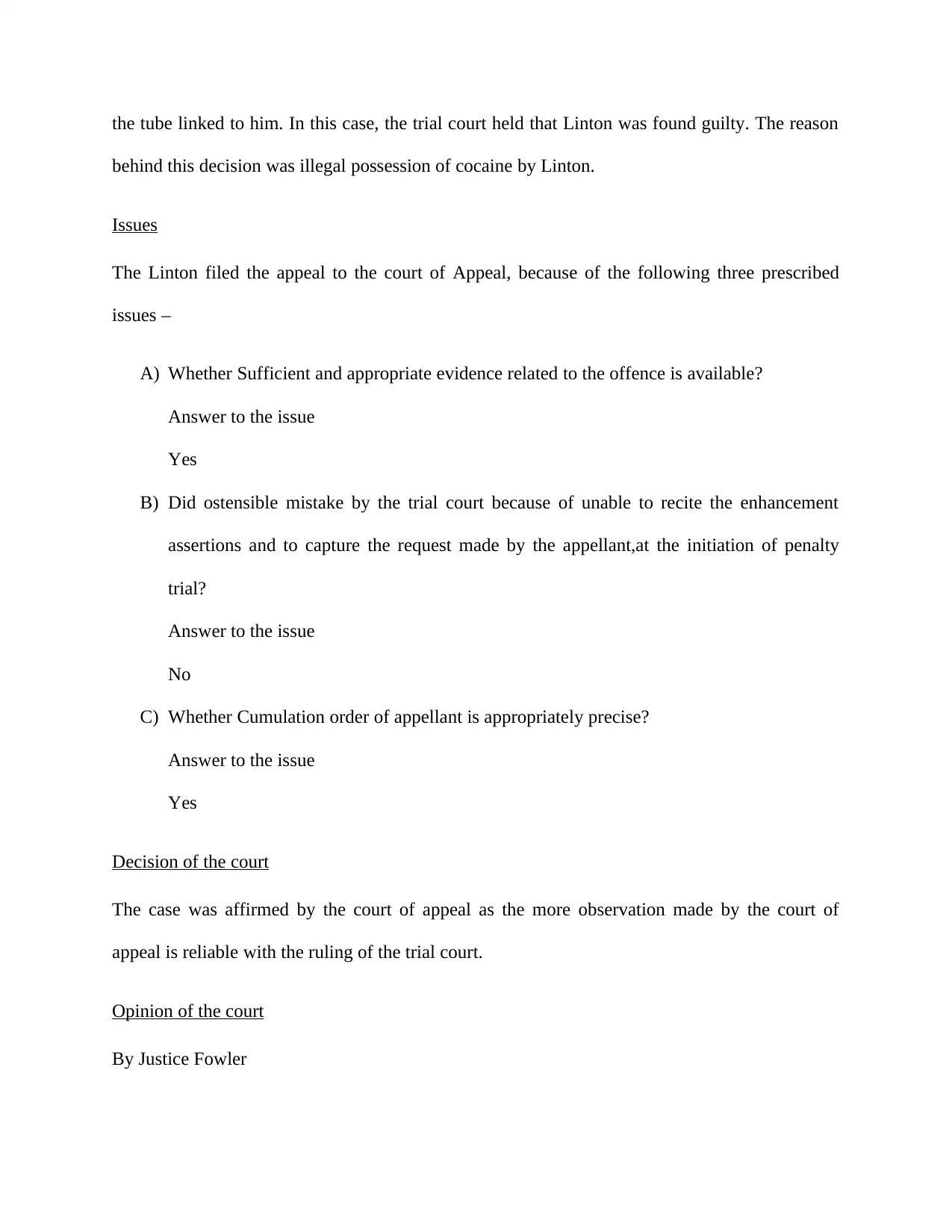
the tube linked to him. In this case, the trial court held that Linton was found guilty. The reason
behind this decision was illegal possession of cocaine by Linton.
Issues
The Linton filed the appeal to the court of Appeal, because of the following three prescribed
issues –
A) Whether Sufficient and appropriate evidence related to the offence is available?
Answer to the issue
Yes
B) Did ostensible mistake by the trial court because of unable to recite the enhancement
assertions and to capture the request made by the appellant,at the initiation of penalty
trial?
Answer to the issue
No
C) Whether Cumulation order of appellant is appropriately precise?
Answer to the issue
Yes
Decision of the court
The case was affirmed by the court of appeal as the more observation made by the court of
appeal is reliable with the ruling of the trial court.
Opinion of the court
By Justice Fowler
behind this decision was illegal possession of cocaine by Linton.
Issues
The Linton filed the appeal to the court of Appeal, because of the following three prescribed
issues –
A) Whether Sufficient and appropriate evidence related to the offence is available?
Answer to the issue
Yes
B) Did ostensible mistake by the trial court because of unable to recite the enhancement
assertions and to capture the request made by the appellant,at the initiation of penalty
trial?
Answer to the issue
No
C) Whether Cumulation order of appellant is appropriately precise?
Answer to the issue
Yes
Decision of the court
The case was affirmed by the court of appeal as the more observation made by the court of
appeal is reliable with the ruling of the trial court.
Opinion of the court
By Justice Fowler
Secure Best Marks with AI Grader
Need help grading? Try our AI Grader for instant feedback on your assignments.
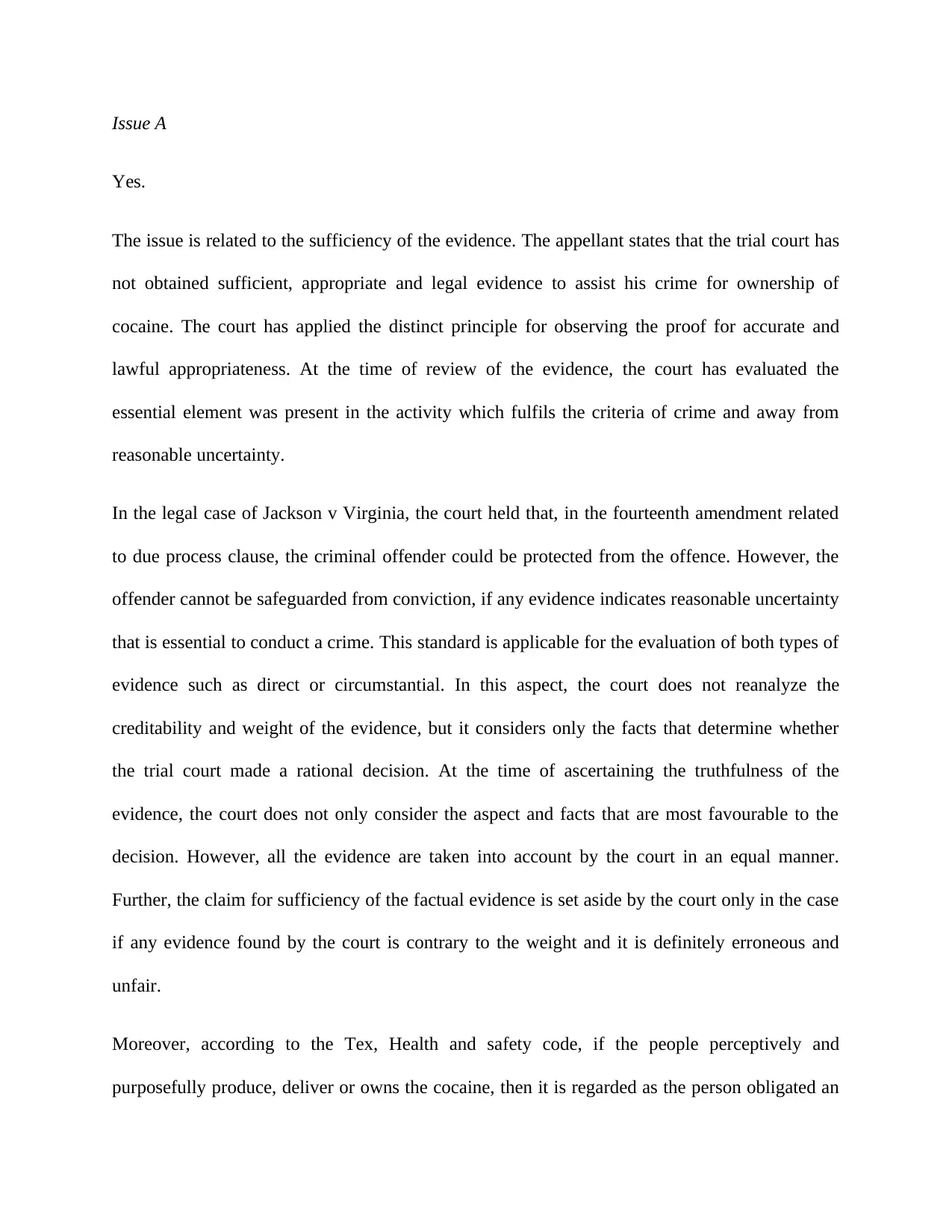
Issue A
Yes.
The issue is related to the sufficiency of the evidence. The appellant states that the trial court has
not obtained sufficient, appropriate and legal evidence to assist his crime for ownership of
cocaine. The court has applied the distinct principle for observing the proof for accurate and
lawful appropriateness. At the time of review of the evidence, the court has evaluated the
essential element was present in the activity which fulfils the criteria of crime and away from
reasonable uncertainty.
In the legal case of Jackson v Virginia, the court held that, in the fourteenth amendment related
to due process clause, the criminal offender could be protected from the offence. However, the
offender cannot be safeguarded from conviction, if any evidence indicates reasonable uncertainty
that is essential to conduct a crime. This standard is applicable for the evaluation of both types of
evidence such as direct or circumstantial. In this aspect, the court does not reanalyze the
creditability and weight of the evidence, but it considers only the facts that determine whether
the trial court made a rational decision. At the time of ascertaining the truthfulness of the
evidence, the court does not only consider the aspect and facts that are most favourable to the
decision. However, all the evidence are taken into account by the court in an equal manner.
Further, the claim for sufficiency of the factual evidence is set aside by the court only in the case
if any evidence found by the court is contrary to the weight and it is definitely erroneous and
unfair.
Moreover, according to the Tex, Health and safety code, if the people perceptively and
purposefully produce, deliver or owns the cocaine, then it is regarded as the person obligated an
Yes.
The issue is related to the sufficiency of the evidence. The appellant states that the trial court has
not obtained sufficient, appropriate and legal evidence to assist his crime for ownership of
cocaine. The court has applied the distinct principle for observing the proof for accurate and
lawful appropriateness. At the time of review of the evidence, the court has evaluated the
essential element was present in the activity which fulfils the criteria of crime and away from
reasonable uncertainty.
In the legal case of Jackson v Virginia, the court held that, in the fourteenth amendment related
to due process clause, the criminal offender could be protected from the offence. However, the
offender cannot be safeguarded from conviction, if any evidence indicates reasonable uncertainty
that is essential to conduct a crime. This standard is applicable for the evaluation of both types of
evidence such as direct or circumstantial. In this aspect, the court does not reanalyze the
creditability and weight of the evidence, but it considers only the facts that determine whether
the trial court made a rational decision. At the time of ascertaining the truthfulness of the
evidence, the court does not only consider the aspect and facts that are most favourable to the
decision. However, all the evidence are taken into account by the court in an equal manner.
Further, the claim for sufficiency of the factual evidence is set aside by the court only in the case
if any evidence found by the court is contrary to the weight and it is definitely erroneous and
unfair.
Moreover, according to the Tex, Health and safety code, if the people perceptively and
purposefully produce, deliver or owns the cocaine, then it is regarded as the person obligated an
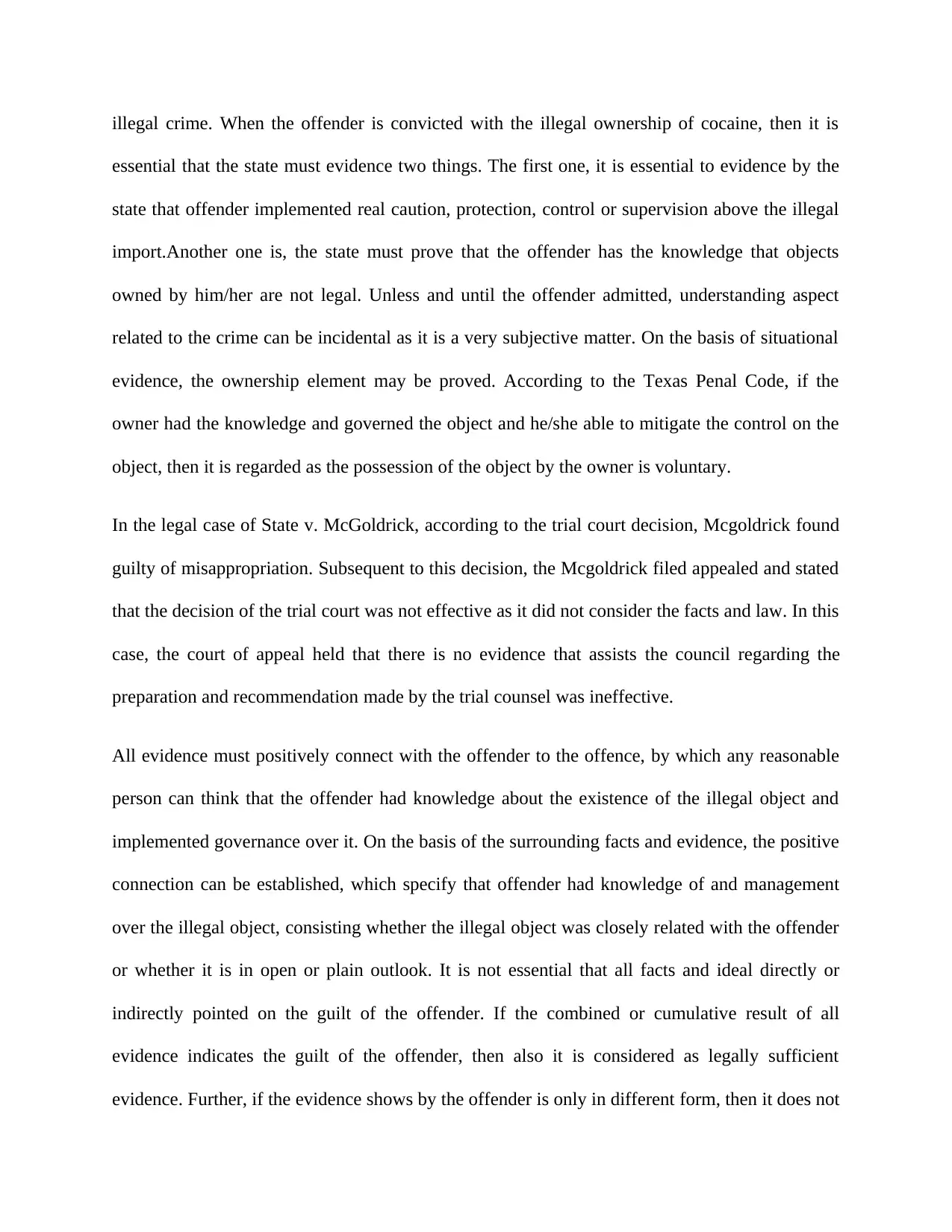
illegal crime. When the offender is convicted with the illegal ownership of cocaine, then it is
essential that the state must evidence two things. The first one, it is essential to evidence by the
state that offender implemented real caution, protection, control or supervision above the illegal
import.Another one is, the state must prove that the offender has the knowledge that objects
owned by him/her are not legal. Unless and until the offender admitted, understanding aspect
related to the crime can be incidental as it is a very subjective matter. On the basis of situational
evidence, the ownership element may be proved. According to the Texas Penal Code, if the
owner had the knowledge and governed the object and he/she able to mitigate the control on the
object, then it is regarded as the possession of the object by the owner is voluntary.
In the legal case of State v. McGoldrick, according to the trial court decision, Mcgoldrick found
guilty of misappropriation. Subsequent to this decision, the Mcgoldrick filed appealed and stated
that the decision of the trial court was not effective as it did not consider the facts and law. In this
case, the court of appeal held that there is no evidence that assists the council regarding the
preparation and recommendation made by the trial counsel was ineffective.
All evidence must positively connect with the offender to the offence, by which any reasonable
person can think that the offender had knowledge about the existence of the illegal object and
implemented governance over it. On the basis of the surrounding facts and evidence, the positive
connection can be established, which specify that offender had knowledge of and management
over the illegal object, consisting whether the illegal object was closely related with the offender
or whether it is in open or plain outlook. It is not essential that all facts and ideal directly or
indirectly pointed on the guilt of the offender. If the combined or cumulative result of all
evidence indicates the guilt of the offender, then also it is considered as legally sufficient
evidence. Further, if the evidence shows by the offender is only in different form, then it does not
essential that the state must evidence two things. The first one, it is essential to evidence by the
state that offender implemented real caution, protection, control or supervision above the illegal
import.Another one is, the state must prove that the offender has the knowledge that objects
owned by him/her are not legal. Unless and until the offender admitted, understanding aspect
related to the crime can be incidental as it is a very subjective matter. On the basis of situational
evidence, the ownership element may be proved. According to the Texas Penal Code, if the
owner had the knowledge and governed the object and he/she able to mitigate the control on the
object, then it is regarded as the possession of the object by the owner is voluntary.
In the legal case of State v. McGoldrick, according to the trial court decision, Mcgoldrick found
guilty of misappropriation. Subsequent to this decision, the Mcgoldrick filed appealed and stated
that the decision of the trial court was not effective as it did not consider the facts and law. In this
case, the court of appeal held that there is no evidence that assists the council regarding the
preparation and recommendation made by the trial counsel was ineffective.
All evidence must positively connect with the offender to the offence, by which any reasonable
person can think that the offender had knowledge about the existence of the illegal object and
implemented governance over it. On the basis of the surrounding facts and evidence, the positive
connection can be established, which specify that offender had knowledge of and management
over the illegal object, consisting whether the illegal object was closely related with the offender
or whether it is in open or plain outlook. It is not essential that all facts and ideal directly or
indirectly pointed on the guilt of the offender. If the combined or cumulative result of all
evidence indicates the guilt of the offender, then also it is considered as legally sufficient
evidence. Further, if the evidence shows by the offender is only in different form, then it does not
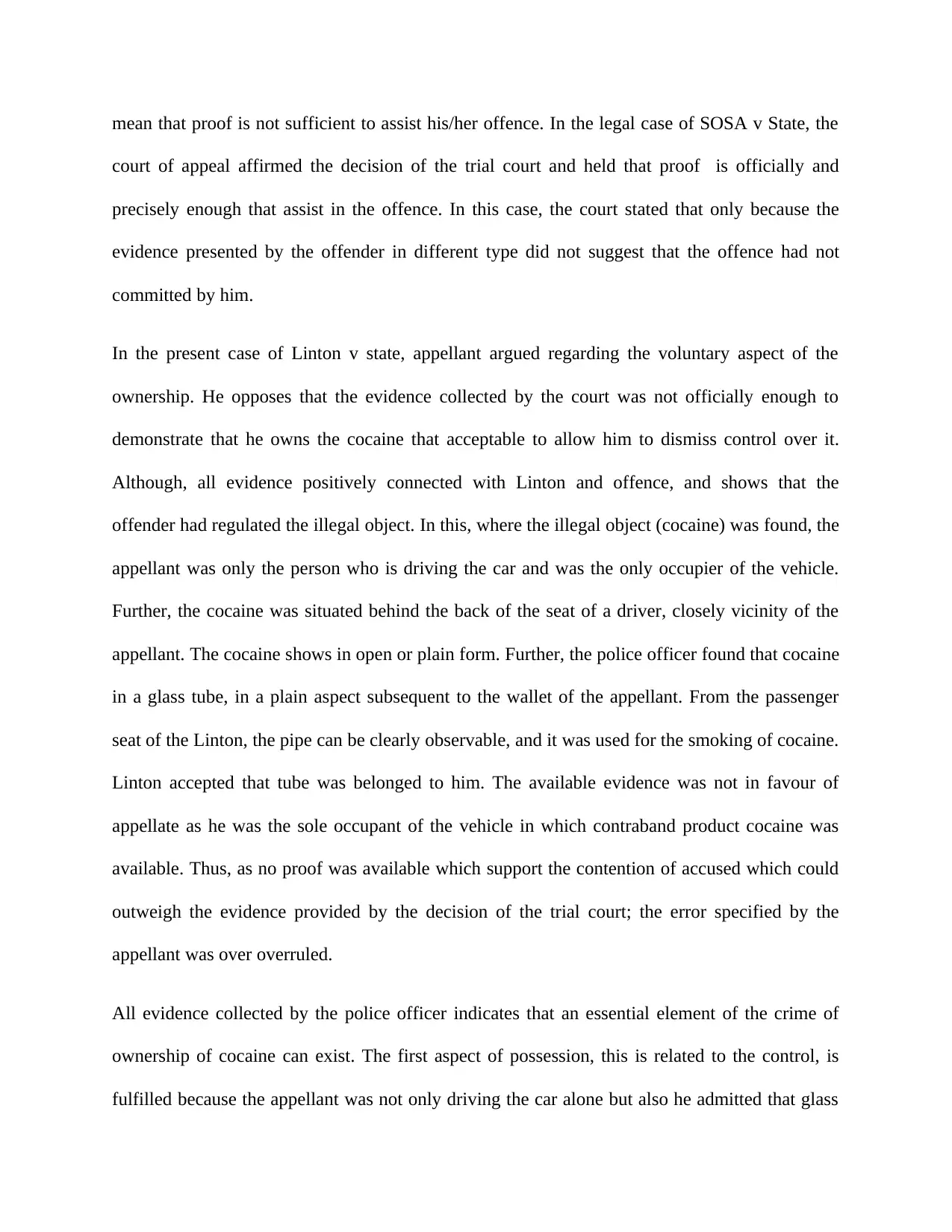
mean that proof is not sufficient to assist his/her offence. In the legal case of SOSA v State, the
court of appeal affirmed the decision of the trial court and held that proof is officially and
precisely enough that assist in the offence. In this case, the court stated that only because the
evidence presented by the offender in different type did not suggest that the offence had not
committed by him.
In the present case of Linton v state, appellant argued regarding the voluntary aspect of the
ownership. He opposes that the evidence collected by the court was not officially enough to
demonstrate that he owns the cocaine that acceptable to allow him to dismiss control over it.
Although, all evidence positively connected with Linton and offence, and shows that the
offender had regulated the illegal object. In this, where the illegal object (cocaine) was found, the
appellant was only the person who is driving the car and was the only occupier of the vehicle.
Further, the cocaine was situated behind the back of the seat of a driver, closely vicinity of the
appellant. The cocaine shows in open or plain form. Further, the police officer found that cocaine
in a glass tube, in a plain aspect subsequent to the wallet of the appellant. From the passenger
seat of the Linton, the pipe can be clearly observable, and it was used for the smoking of cocaine.
Linton accepted that tube was belonged to him. The available evidence was not in favour of
appellate as he was the sole occupant of the vehicle in which contraband product cocaine was
available. Thus, as no proof was available which support the contention of accused which could
outweigh the evidence provided by the decision of the trial court; the error specified by the
appellant was over overruled.
All evidence collected by the police officer indicates that an essential element of the crime of
ownership of cocaine can exist. The first aspect of possession, this is related to the control, is
fulfilled because the appellant was not only driving the car alone but also he admitted that glass
court of appeal affirmed the decision of the trial court and held that proof is officially and
precisely enough that assist in the offence. In this case, the court stated that only because the
evidence presented by the offender in different type did not suggest that the offence had not
committed by him.
In the present case of Linton v state, appellant argued regarding the voluntary aspect of the
ownership. He opposes that the evidence collected by the court was not officially enough to
demonstrate that he owns the cocaine that acceptable to allow him to dismiss control over it.
Although, all evidence positively connected with Linton and offence, and shows that the
offender had regulated the illegal object. In this, where the illegal object (cocaine) was found, the
appellant was only the person who is driving the car and was the only occupier of the vehicle.
Further, the cocaine was situated behind the back of the seat of a driver, closely vicinity of the
appellant. The cocaine shows in open or plain form. Further, the police officer found that cocaine
in a glass tube, in a plain aspect subsequent to the wallet of the appellant. From the passenger
seat of the Linton, the pipe can be clearly observable, and it was used for the smoking of cocaine.
Linton accepted that tube was belonged to him. The available evidence was not in favour of
appellate as he was the sole occupant of the vehicle in which contraband product cocaine was
available. Thus, as no proof was available which support the contention of accused which could
outweigh the evidence provided by the decision of the trial court; the error specified by the
appellant was over overruled.
All evidence collected by the police officer indicates that an essential element of the crime of
ownership of cocaine can exist. The first aspect of possession, this is related to the control, is
fulfilled because the appellant was not only driving the car alone but also he admitted that glass
Paraphrase This Document
Need a fresh take? Get an instant paraphrase of this document with our AI Paraphraser
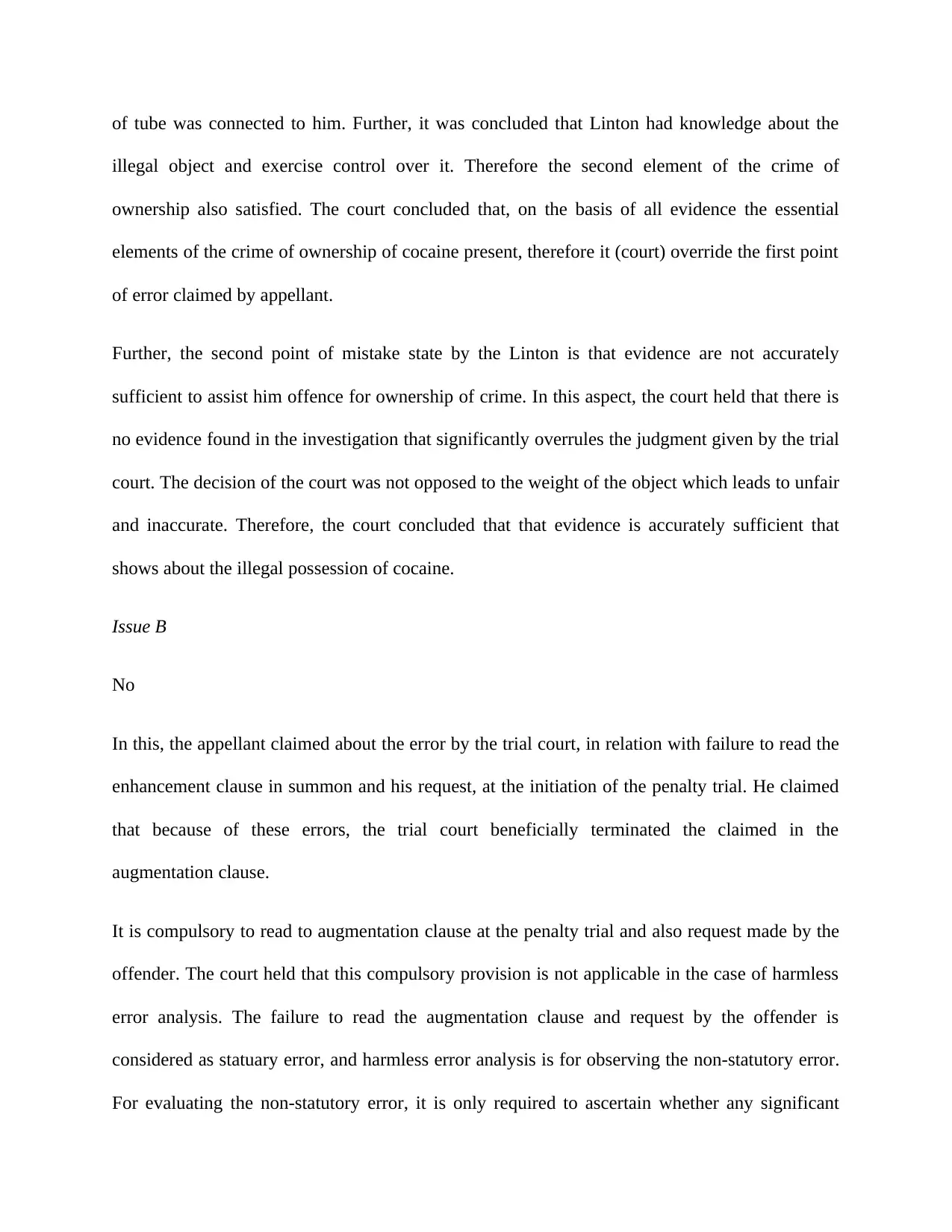
of tube was connected to him. Further, it was concluded that Linton had knowledge about the
illegal object and exercise control over it. Therefore the second element of the crime of
ownership also satisfied. The court concluded that, on the basis of all evidence the essential
elements of the crime of ownership of cocaine present, therefore it (court) override the first point
of error claimed by appellant.
Further, the second point of mistake state by the Linton is that evidence are not accurately
sufficient to assist him offence for ownership of crime. In this aspect, the court held that there is
no evidence found in the investigation that significantly overrules the judgment given by the trial
court. The decision of the court was not opposed to the weight of the object which leads to unfair
and inaccurate. Therefore, the court concluded that that evidence is accurately sufficient that
shows about the illegal possession of cocaine.
Issue B
No
In this, the appellant claimed about the error by the trial court, in relation with failure to read the
enhancement clause in summon and his request, at the initiation of the penalty trial. He claimed
that because of these errors, the trial court beneficially terminated the claimed in the
augmentation clause.
It is compulsory to read to augmentation clause at the penalty trial and also request made by the
offender. The court held that this compulsory provision is not applicable in the case of harmless
error analysis. The failure to read the augmentation clause and request by the offender is
considered as statuary error, and harmless error analysis is for observing the non-statutory error.
For evaluating the non-statutory error, it is only required to ascertain whether any significant
illegal object and exercise control over it. Therefore the second element of the crime of
ownership also satisfied. The court concluded that, on the basis of all evidence the essential
elements of the crime of ownership of cocaine present, therefore it (court) override the first point
of error claimed by appellant.
Further, the second point of mistake state by the Linton is that evidence are not accurately
sufficient to assist him offence for ownership of crime. In this aspect, the court held that there is
no evidence found in the investigation that significantly overrules the judgment given by the trial
court. The decision of the court was not opposed to the weight of the object which leads to unfair
and inaccurate. Therefore, the court concluded that that evidence is accurately sufficient that
shows about the illegal possession of cocaine.
Issue B
No
In this, the appellant claimed about the error by the trial court, in relation with failure to read the
enhancement clause in summon and his request, at the initiation of the penalty trial. He claimed
that because of these errors, the trial court beneficially terminated the claimed in the
augmentation clause.
It is compulsory to read to augmentation clause at the penalty trial and also request made by the
offender. The court held that this compulsory provision is not applicable in the case of harmless
error analysis. The failure to read the augmentation clause and request by the offender is
considered as statuary error, and harmless error analysis is for observing the non-statutory error.
For evaluating the non-statutory error, it is only required to ascertain whether any significant
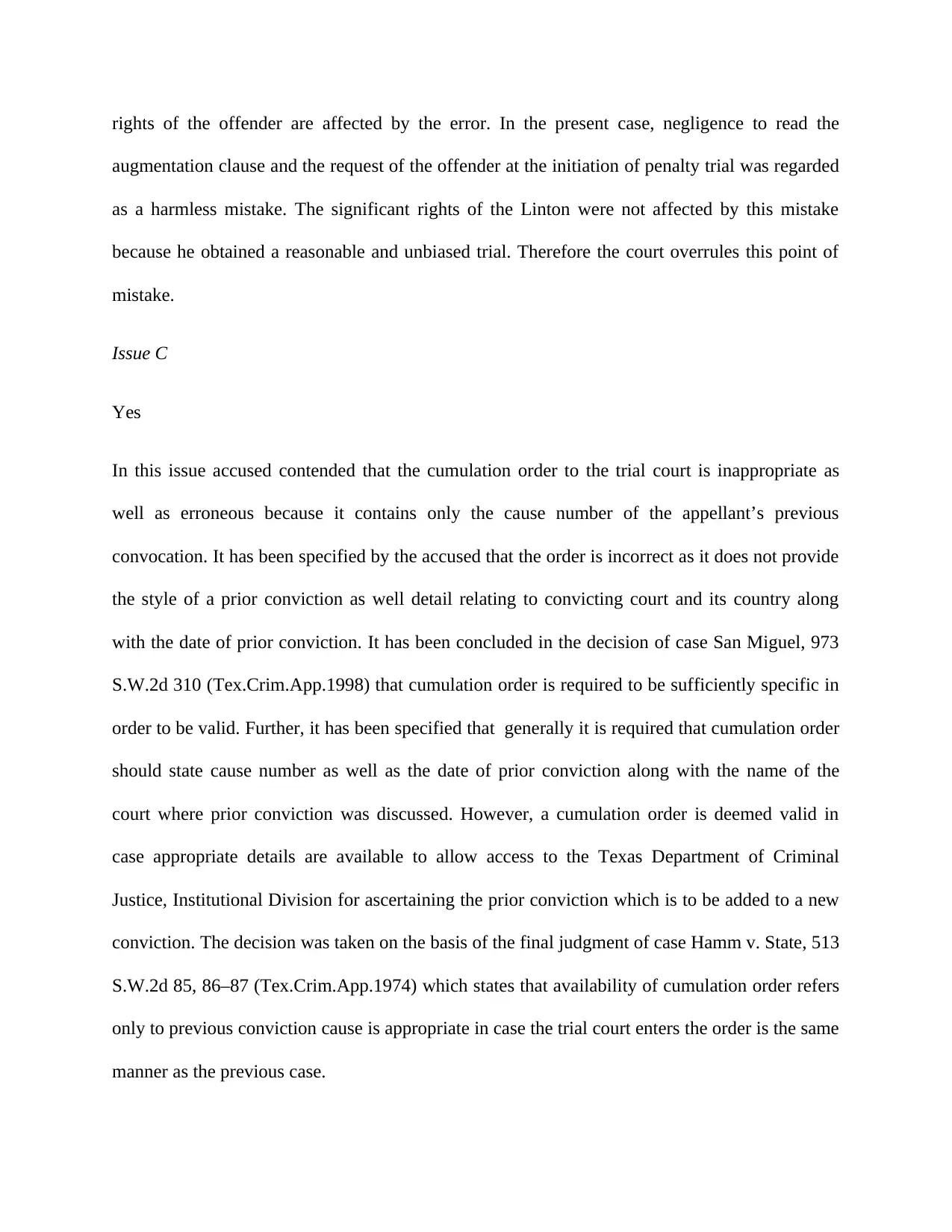
rights of the offender are affected by the error. In the present case, negligence to read the
augmentation clause and the request of the offender at the initiation of penalty trial was regarded
as a harmless mistake. The significant rights of the Linton were not affected by this mistake
because he obtained a reasonable and unbiased trial. Therefore the court overrules this point of
mistake.
Issue C
Yes
In this issue accused contended that the cumulation order to the trial court is inappropriate as
well as erroneous because it contains only the cause number of the appellant’s previous
convocation. It has been specified by the accused that the order is incorrect as it does not provide
the style of a prior conviction as well detail relating to convicting court and its country along
with the date of prior conviction. It has been concluded in the decision of case San Miguel, 973
S.W.2d 310 (Tex.Crim.App.1998) that cumulation order is required to be sufficiently specific in
order to be valid. Further, it has been specified that generally it is required that cumulation order
should state cause number as well as the date of prior conviction along with the name of the
court where prior conviction was discussed. However, a cumulation order is deemed valid in
case appropriate details are available to allow access to the Texas Department of Criminal
Justice, Institutional Division for ascertaining the prior conviction which is to be added to a new
conviction. The decision was taken on the basis of the final judgment of case Hamm v. State, 513
S.W.2d 85, 86–87 (Tex.Crim.App.1974) which states that availability of cumulation order refers
only to previous conviction cause is appropriate in case the trial court enters the order is the same
manner as the previous case.
augmentation clause and the request of the offender at the initiation of penalty trial was regarded
as a harmless mistake. The significant rights of the Linton were not affected by this mistake
because he obtained a reasonable and unbiased trial. Therefore the court overrules this point of
mistake.
Issue C
Yes
In this issue accused contended that the cumulation order to the trial court is inappropriate as
well as erroneous because it contains only the cause number of the appellant’s previous
convocation. It has been specified by the accused that the order is incorrect as it does not provide
the style of a prior conviction as well detail relating to convicting court and its country along
with the date of prior conviction. It has been concluded in the decision of case San Miguel, 973
S.W.2d 310 (Tex.Crim.App.1998) that cumulation order is required to be sufficiently specific in
order to be valid. Further, it has been specified that generally it is required that cumulation order
should state cause number as well as the date of prior conviction along with the name of the
court where prior conviction was discussed. However, a cumulation order is deemed valid in
case appropriate details are available to allow access to the Texas Department of Criminal
Justice, Institutional Division for ascertaining the prior conviction which is to be added to a new
conviction. The decision was taken on the basis of the final judgment of case Hamm v. State, 513
S.W.2d 85, 86–87 (Tex.Crim.App.1974) which states that availability of cumulation order refers
only to previous conviction cause is appropriate in case the trial court enters the order is the same
manner as the previous case.
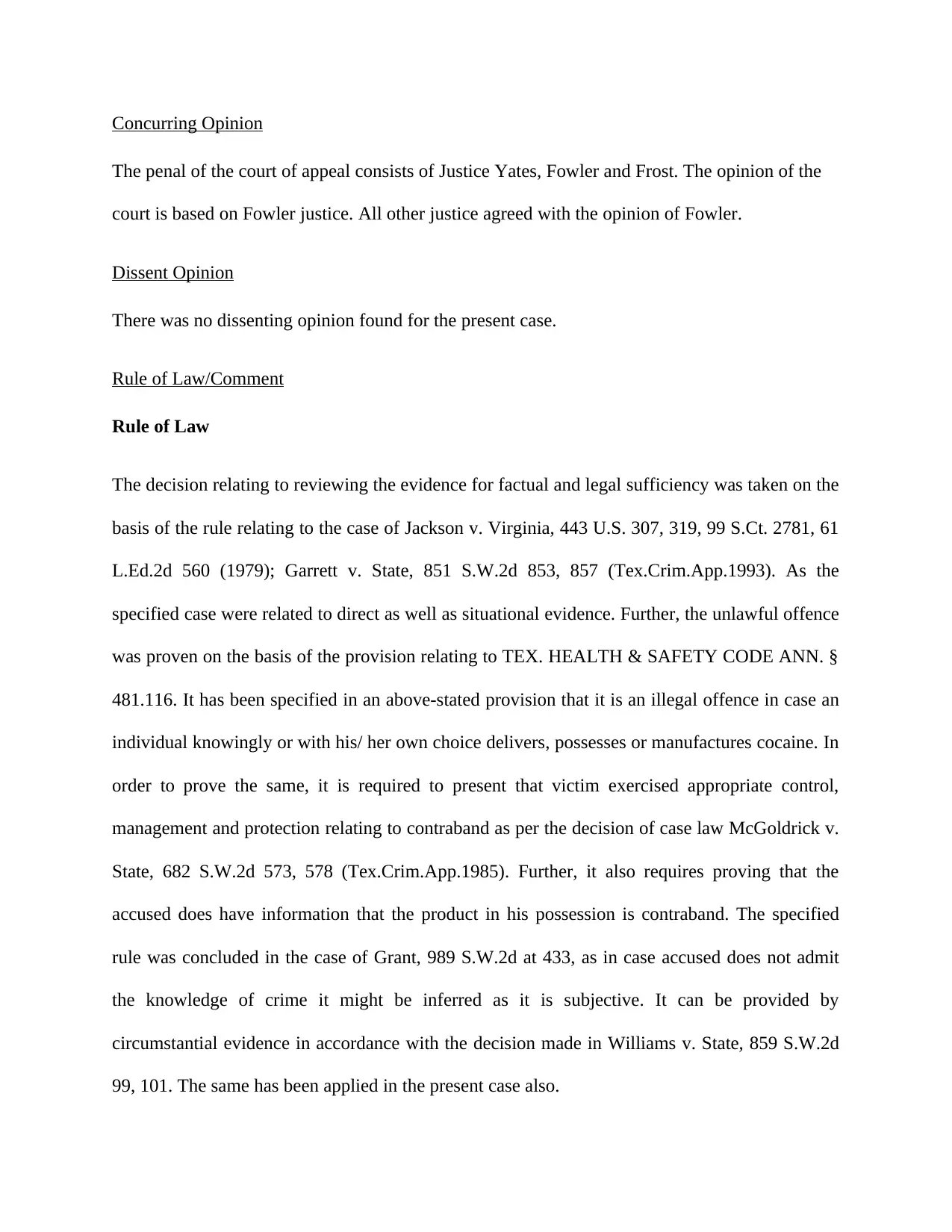
Concurring Opinion
The penal of the court of appeal consists of Justice Yates, Fowler and Frost. The opinion of the
court is based on Fowler justice. All other justice agreed with the opinion of Fowler.
Dissent Opinion
There was no dissenting opinion found for the present case.
Rule of Law/Comment
Rule of Law
The decision relating to reviewing the evidence for factual and legal sufficiency was taken on the
basis of the rule relating to the case of Jackson v. Virginia, 443 U.S. 307, 319, 99 S.Ct. 2781, 61
L.Ed.2d 560 (1979); Garrett v. State, 851 S.W.2d 853, 857 (Tex.Crim.App.1993). As the
specified case were related to direct as well as situational evidence. Further, the unlawful offence
was proven on the basis of the provision relating to TEX. HEALTH & SAFETY CODE ANN. §
481.116. It has been specified in an above-stated provision that it is an illegal offence in case an
individual knowingly or with his/ her own choice delivers, possesses or manufactures cocaine. In
order to prove the same, it is required to present that victim exercised appropriate control,
management and protection relating to contraband as per the decision of case law McGoldrick v.
State, 682 S.W.2d 573, 578 (Tex.Crim.App.1985). Further, it also requires proving that the
accused does have information that the product in his possession is contraband. The specified
rule was concluded in the case of Grant, 989 S.W.2d at 433, as in case accused does not admit
the knowledge of crime it might be inferred as it is subjective. It can be provided by
circumstantial evidence in accordance with the decision made in Williams v. State, 859 S.W.2d
99, 101. The same has been applied in the present case also.
The penal of the court of appeal consists of Justice Yates, Fowler and Frost. The opinion of the
court is based on Fowler justice. All other justice agreed with the opinion of Fowler.
Dissent Opinion
There was no dissenting opinion found for the present case.
Rule of Law/Comment
Rule of Law
The decision relating to reviewing the evidence for factual and legal sufficiency was taken on the
basis of the rule relating to the case of Jackson v. Virginia, 443 U.S. 307, 319, 99 S.Ct. 2781, 61
L.Ed.2d 560 (1979); Garrett v. State, 851 S.W.2d 853, 857 (Tex.Crim.App.1993). As the
specified case were related to direct as well as situational evidence. Further, the unlawful offence
was proven on the basis of the provision relating to TEX. HEALTH & SAFETY CODE ANN. §
481.116. It has been specified in an above-stated provision that it is an illegal offence in case an
individual knowingly or with his/ her own choice delivers, possesses or manufactures cocaine. In
order to prove the same, it is required to present that victim exercised appropriate control,
management and protection relating to contraband as per the decision of case law McGoldrick v.
State, 682 S.W.2d 573, 578 (Tex.Crim.App.1985). Further, it also requires proving that the
accused does have information that the product in his possession is contraband. The specified
rule was concluded in the case of Grant, 989 S.W.2d at 433, as in case accused does not admit
the knowledge of crime it might be inferred as it is subjective. It can be provided by
circumstantial evidence in accordance with the decision made in Williams v. State, 859 S.W.2d
99, 101. The same has been applied in the present case also.
Secure Best Marks with AI Grader
Need help grading? Try our AI Grader for instant feedback on your assignments.
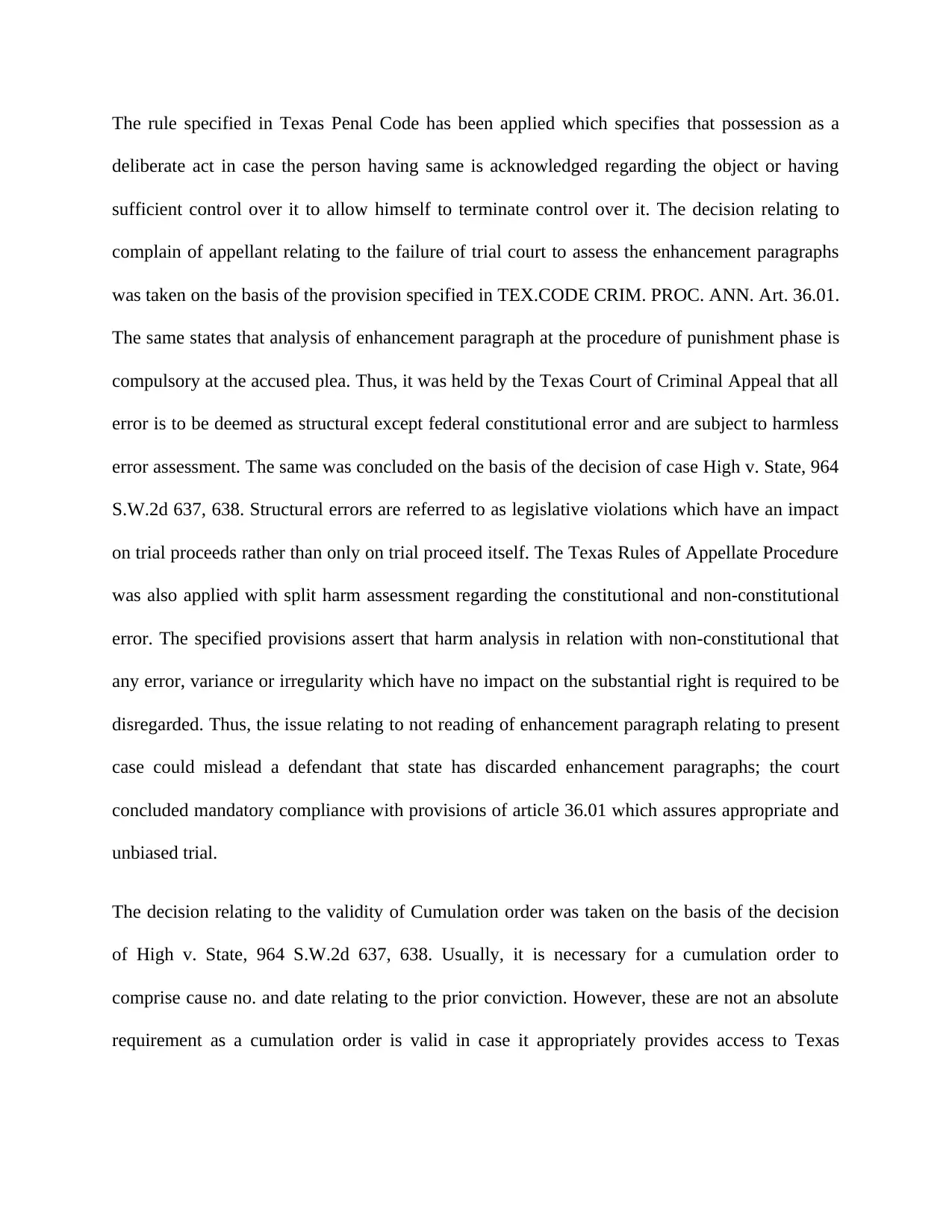
The rule specified in Texas Penal Code has been applied which specifies that possession as a
deliberate act in case the person having same is acknowledged regarding the object or having
sufficient control over it to allow himself to terminate control over it. The decision relating to
complain of appellant relating to the failure of trial court to assess the enhancement paragraphs
was taken on the basis of the provision specified in TEX.CODE CRIM. PROC. ANN. Art. 36.01.
The same states that analysis of enhancement paragraph at the procedure of punishment phase is
compulsory at the accused plea. Thus, it was held by the Texas Court of Criminal Appeal that all
error is to be deemed as structural except federal constitutional error and are subject to harmless
error assessment. The same was concluded on the basis of the decision of case High v. State, 964
S.W.2d 637, 638. Structural errors are referred to as legislative violations which have an impact
on trial proceeds rather than only on trial proceed itself. The Texas Rules of Appellate Procedure
was also applied with split harm assessment regarding the constitutional and non-constitutional
error. The specified provisions assert that harm analysis in relation with non-constitutional that
any error, variance or irregularity which have no impact on the substantial right is required to be
disregarded. Thus, the issue relating to not reading of enhancement paragraph relating to present
case could mislead a defendant that state has discarded enhancement paragraphs; the court
concluded mandatory compliance with provisions of article 36.01 which assures appropriate and
unbiased trial.
The decision relating to the validity of Cumulation order was taken on the basis of the decision
of High v. State, 964 S.W.2d 637, 638. Usually, it is necessary for a cumulation order to
comprise cause no. and date relating to the prior conviction. However, these are not an absolute
requirement as a cumulation order is valid in case it appropriately provides access to Texas
deliberate act in case the person having same is acknowledged regarding the object or having
sufficient control over it to allow himself to terminate control over it. The decision relating to
complain of appellant relating to the failure of trial court to assess the enhancement paragraphs
was taken on the basis of the provision specified in TEX.CODE CRIM. PROC. ANN. Art. 36.01.
The same states that analysis of enhancement paragraph at the procedure of punishment phase is
compulsory at the accused plea. Thus, it was held by the Texas Court of Criminal Appeal that all
error is to be deemed as structural except federal constitutional error and are subject to harmless
error assessment. The same was concluded on the basis of the decision of case High v. State, 964
S.W.2d 637, 638. Structural errors are referred to as legislative violations which have an impact
on trial proceeds rather than only on trial proceed itself. The Texas Rules of Appellate Procedure
was also applied with split harm assessment regarding the constitutional and non-constitutional
error. The specified provisions assert that harm analysis in relation with non-constitutional that
any error, variance or irregularity which have no impact on the substantial right is required to be
disregarded. Thus, the issue relating to not reading of enhancement paragraph relating to present
case could mislead a defendant that state has discarded enhancement paragraphs; the court
concluded mandatory compliance with provisions of article 36.01 which assures appropriate and
unbiased trial.
The decision relating to the validity of Cumulation order was taken on the basis of the decision
of High v. State, 964 S.W.2d 637, 638. Usually, it is necessary for a cumulation order to
comprise cause no. and date relating to the prior conviction. However, these are not an absolute
requirement as a cumulation order is valid in case it appropriately provides access to Texas
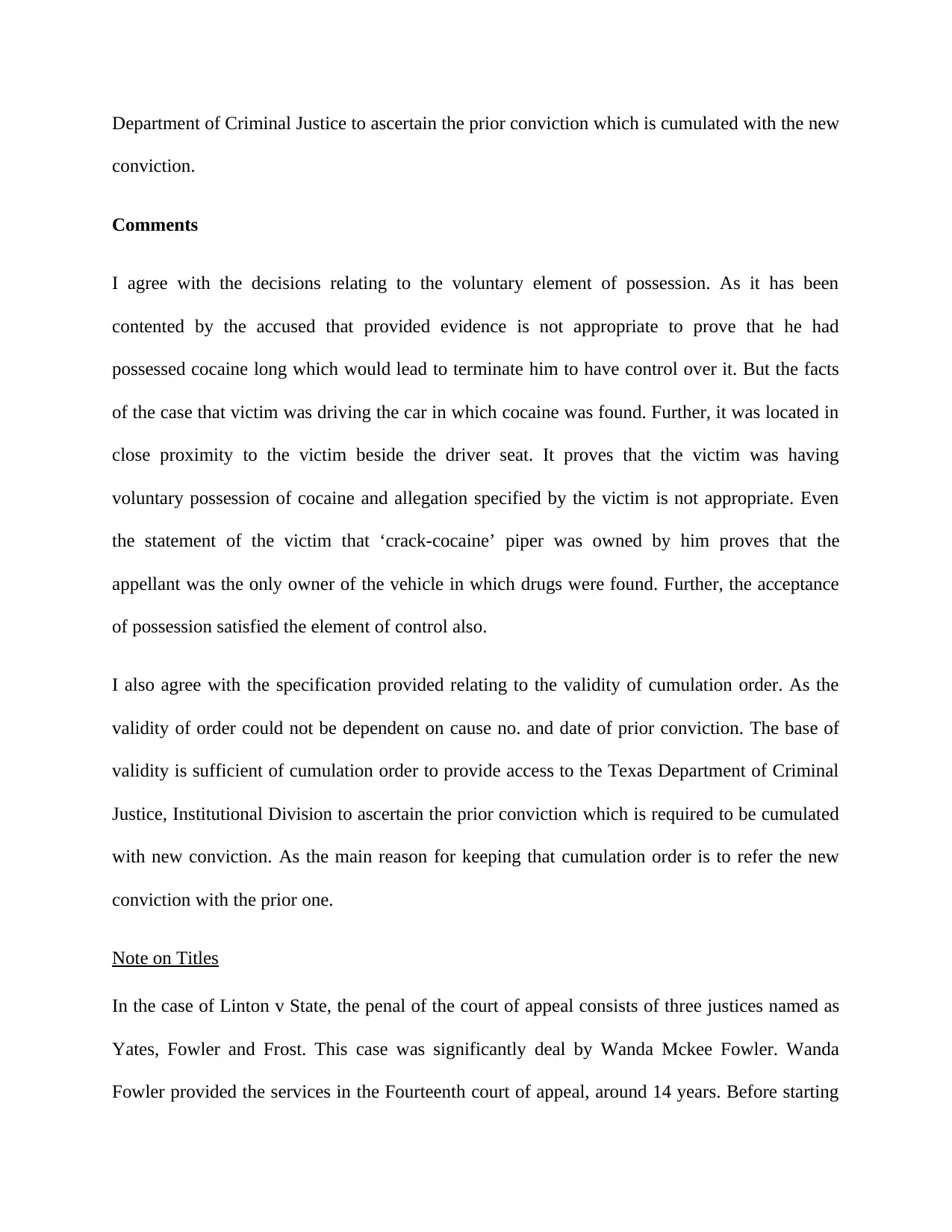
Department of Criminal Justice to ascertain the prior conviction which is cumulated with the new
conviction.
Comments
I agree with the decisions relating to the voluntary element of possession. As it has been
contented by the accused that provided evidence is not appropriate to prove that he had
possessed cocaine long which would lead to terminate him to have control over it. But the facts
of the case that victim was driving the car in which cocaine was found. Further, it was located in
close proximity to the victim beside the driver seat. It proves that the victim was having
voluntary possession of cocaine and allegation specified by the victim is not appropriate. Even
the statement of the victim that ‘crack-cocaine’ piper was owned by him proves that the
appellant was the only owner of the vehicle in which drugs were found. Further, the acceptance
of possession satisfied the element of control also.
I also agree with the specification provided relating to the validity of cumulation order. As the
validity of order could not be dependent on cause no. and date of prior conviction. The base of
validity is sufficient of cumulation order to provide access to the Texas Department of Criminal
Justice, Institutional Division to ascertain the prior conviction which is required to be cumulated
with new conviction. As the main reason for keeping that cumulation order is to refer the new
conviction with the prior one.
Note on Titles
In the case of Linton v State, the penal of the court of appeal consists of three justices named as
Yates, Fowler and Frost. This case was significantly deal by Wanda Mckee Fowler. Wanda
Fowler provided the services in the Fourteenth court of appeal, around 14 years. Before starting
conviction.
Comments
I agree with the decisions relating to the voluntary element of possession. As it has been
contented by the accused that provided evidence is not appropriate to prove that he had
possessed cocaine long which would lead to terminate him to have control over it. But the facts
of the case that victim was driving the car in which cocaine was found. Further, it was located in
close proximity to the victim beside the driver seat. It proves that the victim was having
voluntary possession of cocaine and allegation specified by the victim is not appropriate. Even
the statement of the victim that ‘crack-cocaine’ piper was owned by him proves that the
appellant was the only owner of the vehicle in which drugs were found. Further, the acceptance
of possession satisfied the element of control also.
I also agree with the specification provided relating to the validity of cumulation order. As the
validity of order could not be dependent on cause no. and date of prior conviction. The base of
validity is sufficient of cumulation order to provide access to the Texas Department of Criminal
Justice, Institutional Division to ascertain the prior conviction which is required to be cumulated
with new conviction. As the main reason for keeping that cumulation order is to refer the new
conviction with the prior one.
Note on Titles
In the case of Linton v State, the penal of the court of appeal consists of three justices named as
Yates, Fowler and Frost. This case was significantly deal by Wanda Mckee Fowler. Wanda
Fowler provided the services in the Fourteenth court of appeal, around 14 years. Before starting
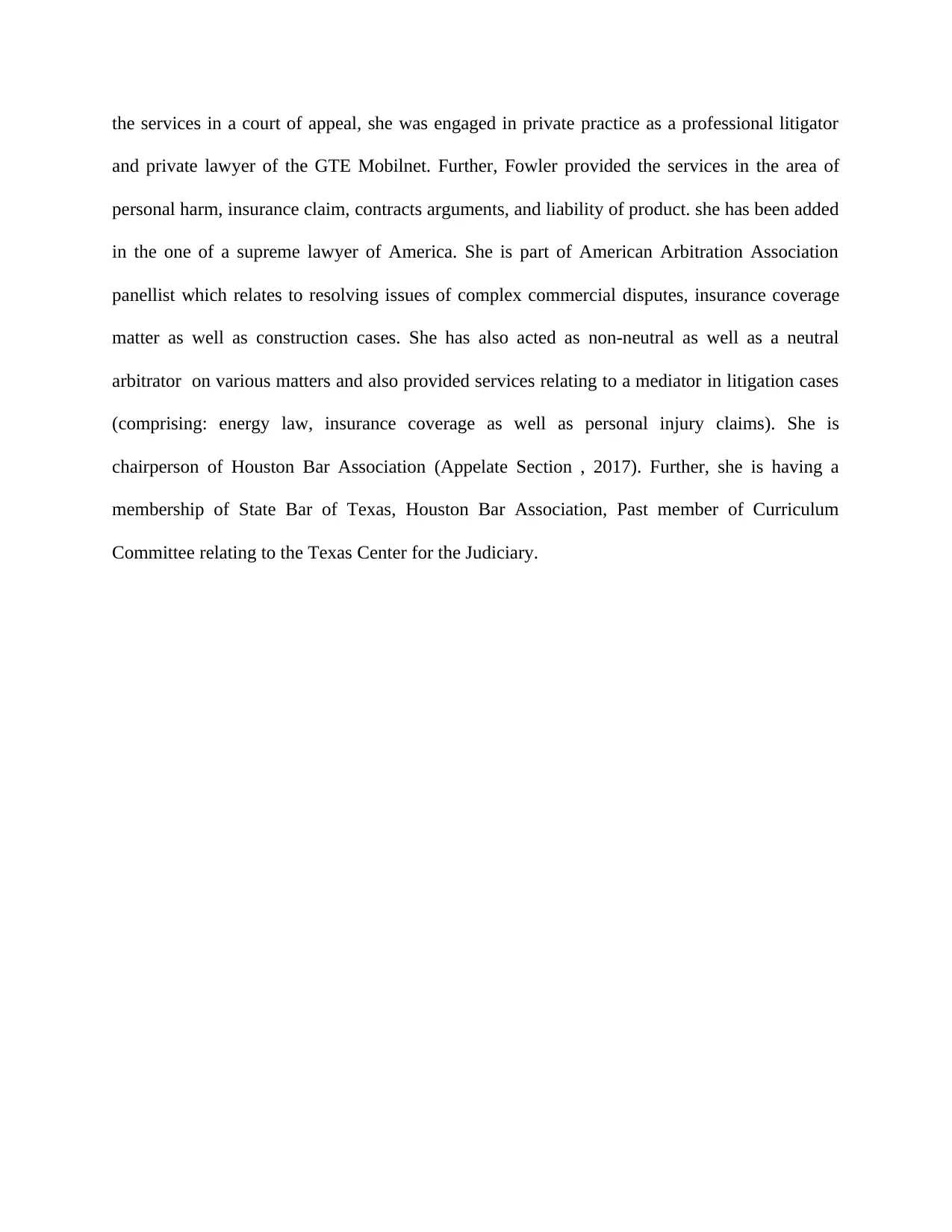
the services in a court of appeal, she was engaged in private practice as a professional litigator
and private lawyer of the GTE Mobilnet. Further, Fowler provided the services in the area of
personal harm, insurance claim, contracts arguments, and liability of product. she has been added
in the one of a supreme lawyer of America. She is part of American Arbitration Association
panellist which relates to resolving issues of complex commercial disputes, insurance coverage
matter as well as construction cases. She has also acted as non-neutral as well as a neutral
arbitrator on various matters and also provided services relating to a mediator in litigation cases
(comprising: energy law, insurance coverage as well as personal injury claims). She is
chairperson of Houston Bar Association (Appelate Section , 2017). Further, she is having a
membership of State Bar of Texas, Houston Bar Association, Past member of Curriculum
Committee relating to the Texas Center for the Judiciary.
and private lawyer of the GTE Mobilnet. Further, Fowler provided the services in the area of
personal harm, insurance claim, contracts arguments, and liability of product. she has been added
in the one of a supreme lawyer of America. She is part of American Arbitration Association
panellist which relates to resolving issues of complex commercial disputes, insurance coverage
matter as well as construction cases. She has also acted as non-neutral as well as a neutral
arbitrator on various matters and also provided services relating to a mediator in litigation cases
(comprising: energy law, insurance coverage as well as personal injury claims). She is
chairperson of Houston Bar Association (Appelate Section , 2017). Further, she is having a
membership of State Bar of Texas, Houston Bar Association, Past member of Curriculum
Committee relating to the Texas Center for the Judiciary.
1 out of 13
Your All-in-One AI-Powered Toolkit for Academic Success.
+13062052269
info@desklib.com
Available 24*7 on WhatsApp / Email
![[object Object]](/_next/static/media/star-bottom.7253800d.svg)
Unlock your academic potential
© 2024 | Zucol Services PVT LTD | All rights reserved.
![R vs. SMITH [2003] QCA 76; 138 A Crim R 172](/_next/image/?url=https%3A%2F%2Fdesklib.com%2Fmedia%2Fimages%2Fci%2F394dee3982ef454f9e4a28ed0b06d045.jpg&w=256&q=75)
![Case Study Analysis: R v HEVKO [2018] SASCFC 22](/_next/image/?url=https%3A%2F%2Fdesklib.com%2Fmedia%2Fr-v-hevko-case-study_page_2.jpg&w=256&q=75)

